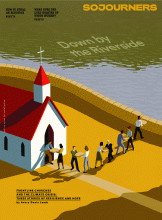OUR LECTIONARY REFLECTIONS for April encompass Palm Sunday and three weeks of readings for Easter. I found these scriptures deeply moving as they presented Jesus of Nazareth through different eyes and in different contexts.
One spring many years ago, our small Mennonite church near Chicago centered our worship services from Easter to Pentecost on stories of Jesus’ resurrection. It was my first experience of “Eastertide,” and I never forgot it. Each week we focused on a different resurrection account in the New Testament—one from each gospel (two from Luke) and 1 Corinthians 15. Comparing different perspectives, our services highlighted the many witnesses to a singular, unexpected event that can help convince us today that this crucified prophet has been resurrected and exalted as Messiah and Lord (see Philippians 2:9-11).
Two more thoughts: First, in the passages below we unfortunately miss the terrifying events after Palm Sunday, during which Jesus confronts the Powers—both high-priestly and Roman—that want to get rid of this “King of the Jews.” Jesus was crucified as a political threat. To accept the risen Jesus as Lord is to take on the (often political) struggle between good and evil in our current contexts.
Second, our faith is not just spiritual. Jesus’ bodily resurrection speaks of the value God places on physical bodies. Though Jesus was black-haired and brown-skinned, God loves all shades and shapes of bodies. Through Jesus’ resurrection, we catch a glimpse of the age to come. It may indeed be, as C.S. Lewis characterizes the new Narnia, deeper and more solid than our present age.
April 5
A Risky Donkey Ride
Isaiah 50:4-9; Psalm 118:1-2, 19-29; Philippians 2:5-11; Matthew 21:1-11
ABOUT 40 YEARS after the original “Palm Sunday” in Jerusalem, the Jewish historian Josephus wrote a history called The Wars of the Jews. In it, he described the welcome received by the Roman Emperor Vespasian when he returned to Rome after destroying Jerusalem and its temple.
The Romans were so fired up that many exited the city to meet him: “The whole multitude ... came into the road and waited for him there.” With great joy, “they styled him their Benefactor and Savior.”
In contrast, Jesus’ “triumphal entry” into Jerusalem parodies the ancient tradition of a victorious king welcomed home to his city after a battle. Rather than riding a white horse, the Middle Eastern Jesus borrows a donkey (Matthew 21:2). Although a large crowd of outsiders created a path for him with cloaks and branches, Jerusalem’s citizens have one startled response: “Who is this?” (verses 8, 10). But even his followers do not call him a king; he is “the prophet Jesus from Nazareth in Galilee” (verse 11).
Rather than a victorious welcome such as Vespasian received, Jesus knows he is raising the stakes in a land as sharply divided as our own. He must nonviolently challenge the corruption that lies at the core of its leadership—Caiaphas and other chief priests who negotiate with Rome for their own interests. Jesus of Nazareth knows his dramatic action will likely result in his execution, but to honor God, he must take the risk.
Only after these Jerusalem events can the “daughter of Zion” go back to her scriptures and find texts such as Zechariah 9:9 where “your king is coming to you, humble, and mounted on a donkey” (Matthew 21:5). Or the song of victory in Psalm 118: “Blessed is the one who comes in the name of the Lord ... bind the festal procession with branches!” (verses 26-27).
Later believers can sing a hymn to their Messiah Jesus (in Philippians 2:6-11), who had “humbled himself to the point of death” and then became exalted above every other human as Lord.
Read the Full Article

